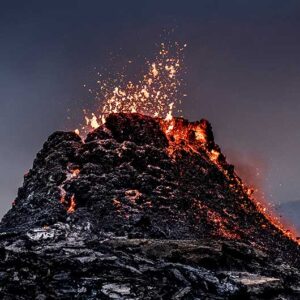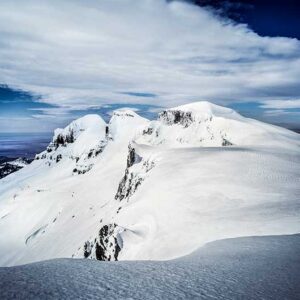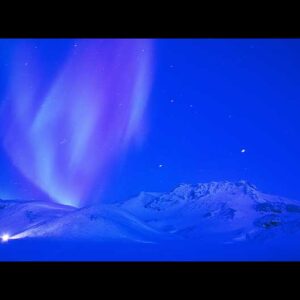-
 Brúará River, South Iceland, October 2019. The Northern Lights create a new world when the light up the landscape. The water and snow get a green hue and a dream-like light from the colorful Northern Lights. The water and light of the sky become one and time stands still. The Northern Lights move a lot and quickly that make the viewer both forget time and place.
Brúará River, South Iceland, October 2019. The Northern Lights create a new world when the light up the landscape. The water and snow get a green hue and a dream-like light from the colorful Northern Lights. The water and light of the sky become one and time stands still. The Northern Lights move a lot and quickly that make the viewer both forget time and place. -
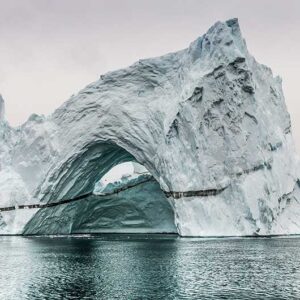 North Atlantic ocean, Greenland Sea, September 2015. The ocean between Iceland and Greenland er built up of large “cities” that are created by floating icebergs that have broken off from the North Pole’s ice sheet and Greenland’s glaciers. The black ash in the middle of this iceberg confirms a volcanic eruption a thousand years ago.
North Atlantic ocean, Greenland Sea, September 2015. The ocean between Iceland and Greenland er built up of large “cities” that are created by floating icebergs that have broken off from the North Pole’s ice sheet and Greenland’s glaciers. The black ash in the middle of this iceberg confirms a volcanic eruption a thousand years ago. -
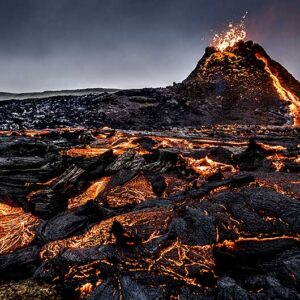 Volcanic eruption in Geldingadölum in Reykjanesi, Apríl 2021. The newly flowing molten lava constantly changes from flowing, lava transforming to hard and rugged rock. The 1100°/C lava cools on the surface when it comes into contact with the cold air and creates rough shell that melts without warning when the molten lava flows piping hot from the crater and rejuvenates itself. “The lava changed in a matter of seconds before my eyes as I stood opposite the volcano and took this photo. It was almost as if the volcano called to me, it was as if it had a magnet pull and begged me to come closer to it, walking on the hard and porous lava. Suddenly it changed again, back into molten lava that destroys everything that it touches.”
Volcanic eruption in Geldingadölum in Reykjanesi, Apríl 2021. The newly flowing molten lava constantly changes from flowing, lava transforming to hard and rugged rock. The 1100°/C lava cools on the surface when it comes into contact with the cold air and creates rough shell that melts without warning when the molten lava flows piping hot from the crater and rejuvenates itself. “The lava changed in a matter of seconds before my eyes as I stood opposite the volcano and took this photo. It was almost as if the volcano called to me, it was as if it had a magnet pull and begged me to come closer to it, walking on the hard and porous lava. Suddenly it changed again, back into molten lava that destroys everything that it touches.” -
 When the piping hot lava quickly cools when it touches the newly fallen snow, a lot of steam is created that surrounds the crater when it bursts through the Earth’s surface. The volcano peeks through the steam’s ever-changing window. It can be dangerous to inhale the steam because it can be poisonous.
When the piping hot lava quickly cools when it touches the newly fallen snow, a lot of steam is created that surrounds the crater when it bursts through the Earth’s surface. The volcano peeks through the steam’s ever-changing window. It can be dangerous to inhale the steam because it can be poisonous. -
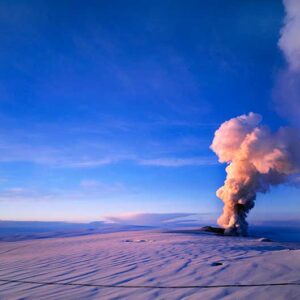 Grímsfjall Vatnajökull, Iceland 1998. Vatnajökull is Europe’s largest glacier, and the volcanic center of Grímsfjall erupts there regularly. I went to the Grímsfjalli eruption in my car with short notice in November of 1998 to capture it. It had snowed during the night on the glacier that changed the black ash-covered surface with a beautiful white blanket of snow for a short moment. My tire tracks left black marks on the glacier.
Grímsfjall Vatnajökull, Iceland 1998. Vatnajökull is Europe’s largest glacier, and the volcanic center of Grímsfjall erupts there regularly. I went to the Grímsfjalli eruption in my car with short notice in November of 1998 to capture it. It had snowed during the night on the glacier that changed the black ash-covered surface with a beautiful white blanket of snow for a short moment. My tire tracks left black marks on the glacier. -
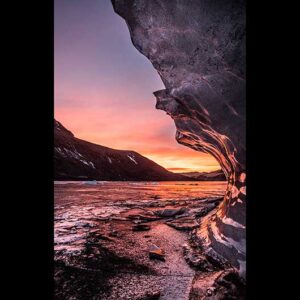 Sólheimajökull South coast Iceland, January 2021. It is an adventure to visit these crawling glaciers at night, when the sun departs us and the night descends on us, the glacier speaks loudly with its sounds of breaking and cracking, both intimidating as well as friendly sounds that remind you to be cautious in this ever-changing landscape.
Sólheimajökull South coast Iceland, January 2021. It is an adventure to visit these crawling glaciers at night, when the sun departs us and the night descends on us, the glacier speaks loudly with its sounds of breaking and cracking, both intimidating as well as friendly sounds that remind you to be cautious in this ever-changing landscape.

